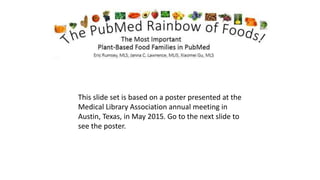1. This slide set is based on a poster presented at the
Medical Library Association annual meeting in
Austin, Texas, in May 2015. Go to the next slide to
see the poster.
2. For details about the poster, and how this slide set expands upon it, go to the next slide.
3. Searching for plant-based foods
(PBFs) in PubMed is tricky because
most of these are indexed in the
Plants explosion, and not in the Food
explosion.
This has disadvantages for searching,
but it also has the advantage that
PBFs are classified by plant family,
with related plants together. This is
valuable because plant families have
biochemical distinctiveness, which
affects their nutrition.
Combining a Food-Diet-Nutrition
hedge that we have developed with
all the plant families in MeSH, we
have been able to determine which
families have the most food-related
articles in PubMed.
The ranking of families starts in the
left column. Not surprisingly, the top
three families are beans, grains and
potatoes-tomatoes. After that you
may see some surprises.
The hedge we used to combine with
each plant family is:
(food and beverages[majr]) OR
(Nutritional Physiological
Phenomena[majr]) OR (nutrition
disorders[majr]) OR (food
industry[majr])
The number of citations goes from
Fabaceae (6747 articles) to
Clusiaceae (85 articles).
Text from the poster, in three columns, as it appears on the poster
This slide set expands on the poster in two ways:
It has MeSH tree information for each of the 30 families on
the poster, including MeSH terms and equivalent common
names. Most families include selected MeSH terms;
otherwise, “complete MeSH" indicates that all MeSH terms
are given.
In most cases, the slide set includes
additional images for families, beyond the
one image that's in the poster (All images
are licensed for educational use; rights
information is given for all images at the
end of the slide set).
4. Fabaceae
Beans (Phaseolus)
Lentil beans
Soybeans
Arachis (Peanuts)
Aspalathus (Rooibo)
Cajanus (Pigeonpea)
Cicer (Chickpea)
Glycyrrhiza (Liquorice)
Lens Plant (Lentil)
Mucuna (Velvet Bean)
Pachyrhizus (Jicama)
Peas (Pisum sativum)
Phaseolus (Common edible BEANS)
Pueraria (Kudzu)
Soybeans
Tamarindus (Tamarind)
Trigonella (Fenugreek)
MeSH: Fabaceae (Link):
5. Poaceae
Rice Wheat
Corn
Avena sativa (Oats)
Bambusa (Bamboo)
Eragrostis (Teff)
Hordeum (Barley)
Oryza sativa (Rice)
Panicum (Millet)
Saccharum (Sugarcane)
Secale cereale (Rye)
Sorghum
Triticum (Wheat)
Zea mays (Corn)
MeSH: Poaceae (Link):
10. Rosaceae
Apple Peach Strawberry
Crataegus (Hawthorn)
Eriobotrya (Loquat Tree)
Fragaria (Strawberry)
Malus (Apple)
Photinia (Aronia)
Prunus (Almond, Apricot,
Cherry, Peach, Plum)
Pyrus (Pear)
Rubus (Raspberry,
Blackberry)
MeSH: Rosaceae (Link):
11. Asteraceae
Sunflower nuts
Sunchoke Lettuce
Carthamus tinctorius (Safflower)
Chicory
Chrysanthemum
Cynara scolymus (Artichoke)
Helianthus (Sunflower, Sunchoke)
Lettuce
Stevia (Sweeting agent)
Tanacetum parthenium
(Feverfew)
Taraxacum (Dandelion)
MeSH: Asteraceae (Link):
14. Apiaceae
Carrot Celery
Parsley
Anethum graveolens (Dill)
Angelica
Apium graveolens (Celery)
Carum (Caraway)
Centella (Gotu kola)
Coriandrum (Coriander)
Cuminum (Cumin)
Daucus carota (Carrot)
Ferula (Asafoetida)
Foeniculum (Fennel)
Levisticum (Lovage)
Pastinaca (Parsnip)
Petroselinum (Parsley)
Pimpinella (Anise)
MeSH: Apiaceae (Link):
34. Fabaceae
Beans (Phaseolus): http://commons.wikimedia.org/wiki/File:Painted_Pony_Bean.JPG
Lentil beans: http://commons.wikimedia.org/wiki/File:3_types_of_lentil.jpg
Soybeans:
http://commons.wikimedia.org/wiki/File:Edamame_by_Zesmerelda_in_Chicago.jpg
Poaceae
Rice: http://commons.wikimedia.org/wiki/File:White,_Brown,_Red_%26_Wild_rice.jpg
Wheat: http://commons.wikimedia.org/wiki/File:Wheat_close-up.JPG
Corn: Personal photo
Solanaceae
Potato: http://commons.wikimedia.org/wiki/File:Patates.jpg
Tomato: http://commons.wikimedia.org/wiki/File:End_of_Summer_Tomatoes.jpg
Liliaceae
Garlic:
http://commons.wikimedia.org/wiki/File:Allium_sativum._Restra_de_allos_de_Oroso-
_Galiza.jpg
Asparagus: http://commons.wikimedia.org/wiki/File:Asparagus-Bundle.jpg
Onion: http://commons.wikimedia.org/wiki/File:Onion_on_White.JPG
Rutaceae
Mixed citrus: http://pixabay.com/en/fruit-food-citrus-pomelo-15408/
Orange: http://commons.wikimedia.org/wiki/File:Orange-Fruit-Pieces.jpg
Grapefruit:
http://commons.wikimedia.org/wiki/File:Citrus_paradisi_(Grapefruit,_pink)_white_bg.jpg
Brassicaceae
Cabbage: http://commons.wikimedia.org/wiki/File:Chou_fris%C3%A9_02.jpg
Broccoli: http://commons.wikimedia.org/wiki/File:Broccoli_DSC00861.png
Kale: http://commons.wikimedia.org/wiki/File:Boerenkool.jpg
Rosaceae
Apple: http://commons.wikimedia.org/wiki/File:Red_Apple.jpg
Peach: http://commons.wikimedia.org/wiki/File:Nectarine.jpg
Strawberry: http://commons.wikimedia.org/wiki/File:PerfectStrawberry.jpg
Asteraceae
Sunflower nuts: http://pixabay.com/en/food-snack-seeds-sunflower-316024/
Sunchoke: http://commons.wikimedia.org/wiki/File:Topinambur_gomolj.jpg
Lettuce: http://commons.wikimedia.org/wiki/File:Romaine.jpg
Sterculiaceae
Chocolate: http://en.wikipedia.org/wiki/File:ChocolateA.jpg
Vitaceae
Grapes: http://commons.wikimedia.org/wiki/File:Alicante_Bouschet.jpg
Apiaceae
Carrot: http://pixabay.com/en/orange-carrots-white-close-up-food-2794/
Celery: http://commons.wikimedia.org/wiki/File:C%C3%A9leri.jpg
Parsley: http://commons.wikimedia.org/wiki/File:Petersilie_Kraus.jpg
Chenopodiaceae
Beets: http://commons.wikimedia.org/wiki/File:CDC_beets.jpg
Quinoa: http://commons.wikimedia.org/wiki/File:Red_quinoa.png
Spinach: http://pixabay.com/en/spinach-leaf-spinach-salad-leaves-74220/
Polygonaceae
Buckwheat: https://www.flickr.com/photos/ervins_strauhmanis/9545949677/
Arecaceae
Coconut: https://www.flickr.com/photos/yimhafiz/4031507140/
Date: http://commons.wikimedia.org/wiki/File:Medjool-Date.jpg
Credits for images & quotes
All images are public domain or licensed to use with attribution. Google
Image Search was invaluable in finding the images. Of the 61 images, 47 are
from Wikimedia, 9 from Pixabay, 3 from Flickr, and 2 are personal photos.
(Continued…)
35. Ericaceae
Blueberry: http://pixabay.com/p-2271/
Cranberry: http://commons.wikimedia.org/wiki/File:Cranberries20101210.jpg
Theaceae
Tea:
http://commons.wikimedia.org/wiki/File:Tea_in_different_grade_of_fermentat
ion.jpg
Euphorbiaceae
Cassava: http://commons.wikimedia.org/wiki/File:Manihot_esculenta_-
_cross_section_2.jpg
Quote: http://en.wikipedia.org/wiki/Cassava
Cucurbitaceae
Watermelon: http://commons.wikimedia.org/wiki/File:Owoce_Arbuz.jpg
Squash: http://pixabay.com/en/butternut-pumpkin-butternut-squash-74196/
Cucumber: http://commons.wikimedia.org/wiki/File:ARS_cucumber.jpg
Lamiaceae
Basil: http://commons.wikimedia.org/wiki/File:Basilikum-Bl%C3%A4tter.jpg
Sage: http://pixabay.com/en/sage-kraeuer-spice-sage-leaves-74326/
Peppermint: http://commons.wikimedia.org/wiki/File:Mint-leaves-2007.jpg
Linaceae
Flax seed:
http://commons.wikimedia.org/wiki/File:Owoce_Orzech_laskowy.jpg
Lauraceae
Avocado: https://farm2.staticflickr.com/1221/793672848_6d26265c4d_o.jpg
Cinnamon: http://commons.wikimedia.org/wiki/File:Cinnamon-other.jpg
Anacardiaceae
Mango: http://pixabay.com/en/mango-fruit-sliced-exotic-orange-390685/
Cashew nut: http://commons.wikimedia.org/wiki/File:Cashew_apples.jpg
Pistachio: http://commons.wikimedia.org/wiki/File:Pistachio.jpg
Araliaceae
Ginseng: http://commons.wikimedia.org/wiki/File:Panax_quinquefolius.jpg
Punicaceae
Pomegranate: http://commons.wikimedia.org/wiki/File:Granatapfel_2013.jpg
Oleaceae
Olive Oil: http://commons.wikimedia.org/wiki/File:Olive_oil_from_Oneglia.jpg
Rubiaceae
Coffee: http://pixabay.com/en/coffee-cafe-coffee-cream-restaurant-206142/
Quote: http://en.wikipedia.org/wiki/Rubiaceae#Food
Zingiberaceae
Ginger: http://commons.wikimedia.org/wiki/File:Fresh_Ginger.JPG
Turmeric: Personal photo
Cardamom: http://commons.wikimedia.org/wiki/File:Cardamone.jpg
Juglandaceae
Walnut:
http://commons.wikimedia.org/wiki/File:Walnuts,_Mercado_La_Boquer%C3%ADa
.jpg
Pecan: http://commons.wikimedia.org/wiki/File:Pecans-4352.jpg
Betulaceae
Hazel nut: http://en.wikipedia.org/wiki/File:Hazelnuts.jpg
Clusiaceae
Mangosteen: http://commons.wikimedia.org/wiki/File:Mangosteen.jpeg
Quote: http://www.latimes.com/food/dailydish/la-dd-mangosteen-most-delicious-
fruit-on-earth20130829-story.html
